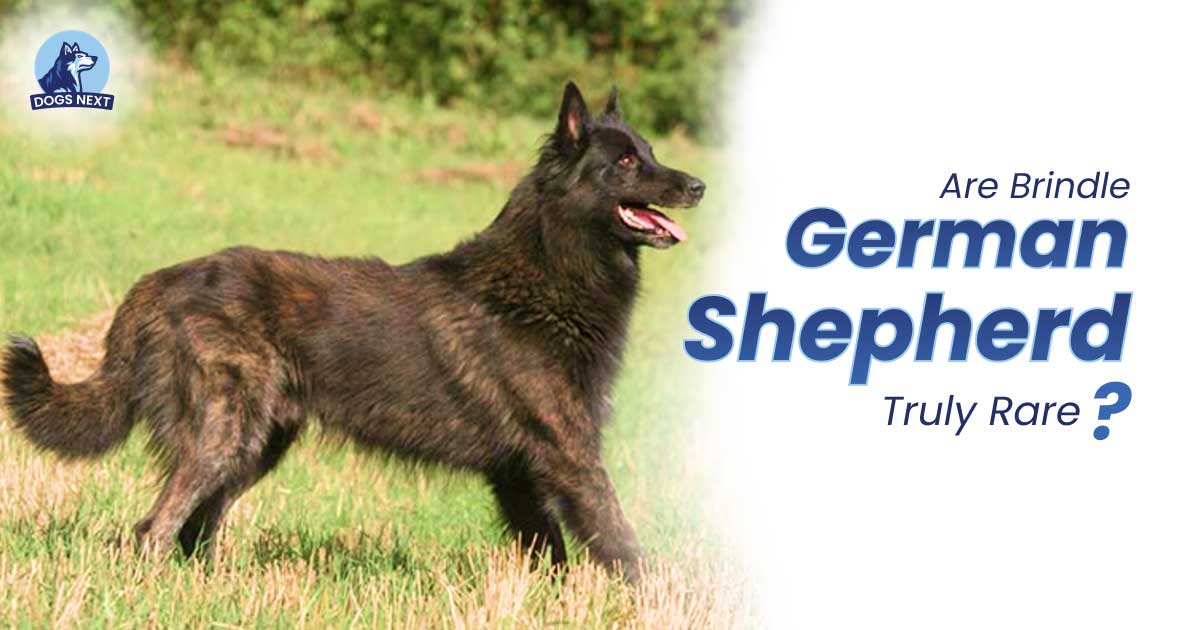Brindle German Shepherds are indeed rare. Their unique coat pattern is not commonly found in the breed.
Brindle German Shepherds stand out due to their uncommon and striking coat pattern. This rarity stems from genetics that are not typical in the breed’s lineage. Enthusiasts often seek out these dogs for their distinctive appearance and the unique traits they bring to the table.
Although not recognized as a standard color by some breed registries, these German Shepherds still possess the same loyal, intelligent, and protective qualities the breed is known for. Owning a Brindle German Shepherd can be a unique experience, offering the same companionship and working abilities with a touch of rarity that many dog owners find appealing.
Understanding Brindle Coloring
Are Brindle German Shepherds truly rare? The answer isn’t straightforward. Understanding the unique brindle coloring helps explain their rarity. This pattern features streaks of different colors on the dog’s coat, creating a tiger-stripe effect. Let’s delve deeper into the genetics behind brindle coloring.
Genetics Behind Brindle Coloring
Brindle coloring in German Shepherds results from specific genetic combinations. The brindle gene, known as the “K locus,” plays a crucial role. This gene has three alleles: “Kbr” (brindle), “ky” (allows other colors), and “K” (dominant black).
The presence of the “Kbr” allele is essential for brindle patterns. Here’s a simple breakdown:
- KbrKbr: Brindle
- Kbrky: Brindle
- Kky: Dominant black, no brindle
Brindle patterns appear when at least one “Kbr” allele is present. This explains why brindle German Shepherds are rare. The “Kbr” allele must be inherited from both parents, which doesn’t happen often.
Below is a table summarizing the genetic combinations:
| Genotype | Phenotype |
| KbrKbr | Brindle |
| Kbrky | Brindle |
| Kky | Dominant Black |
The rarity of brindle German Shepherds also ties to breeding practices. Many breeders focus on traditional colors like black and tan. As a result, the brindle gene doesn’t get passed on often. This selective breeding further reduces the chances of encountering brindle German Shepherds.
Understanding these genetics helps appreciate the uniqueness and rarity of brindle German Shepherds. It’s fascinating how specific gene combinations create such distinctive patterns. This knowledge adds to the allure of these beautiful dogs.
Brindle German Shepherds
Brindle German Shepherds are a unique and striking variation of the beloved German Shepherd breed. Known for their distinctive coat pattern, these dogs have a mix of colors that create a tiger-like appearance.
Many wonder if these brindle-patterned dogs are truly rare and what makes them stand out in the world of German Shepherds. Let’s dive into the fascinating details about Brindle German Shepherds.
Overview Of The Breed
German Shepherds are renowned for their intelligence, loyalty, and versatility. They are often used in police and military roles, as well as being popular family pets. The breed typically has a strong, muscular build and a double coat that can come in various colors including black, tan, sable, and white.
Brindle German Shepherds, however, have a unique coat pattern. Brindle refers to a mix of dark and light stripes that create a tiger-like effect.
This pattern can vary widely, with some dogs having very pronounced stripes and others having a more subtle blend of colors.
- Temperament: Loyal, intelligent, and protective.
- Lifespan: 9-13 years.
- Height: Males: 24-26 inches, Females: 22-24 inches.
- Weight: Males: 65-90 pounds, Females: 50-70 pounds.
This breed’s coat requires regular grooming to manage shedding and maintain its appearance. Their high energy levels mean they need plenty of exercise and mental stimulation.
Brindle German Shepherds are as capable and trainable as their non-brindle counterparts, making them excellent working dogs and family companions.
Historical Background And Occurrence Of Brindle Pattern
The brindle pattern in German Shepherds has an intriguing history. The German Shepherd breed was established in the late 19th century by Captain Max von Stephanitz.
The breed’s primary purpose was herding and guarding sheep, which required a versatile and hardworking dog.
While the standard colors for German Shepherds are well-known, the brindle pattern is less common. This pattern occurs due to genetic variations, specifically the presence of the kbr gene. This gene is responsible for the brindle striping seen in some dogs.
Historically, the brindle pattern was more prevalent in the early German Shepherd breed. Over time, selective breeding for specific traits led to the decline of this pattern.
Today, brindle German Shepherds are rare, and the appearance of this pattern is usually due to a recessive gene. The rarity of the brindle pattern adds to the uniqueness and allure of these dogs.
Table of Brindle Pattern Occurrence:Time PeriodBrindle Pattern PrevalenceLate 19th CenturyMore CommonEarly 20th CenturyDecliningModern DayRare
Despite their rarity, brindle German Shepherds continue to capture the hearts of dog lovers. Their unique coat pattern, combined with the breed’s well-known traits, makes them a fascinating and desirable variant of the German Shepherd.
Rarity Of Brindle German Shepherds
German Shepherds are known for their loyalty, intelligence, and versatility. Among their many color patterns, brindle is considered one of the rarest. But how rare are brindle German Shepherds, and what makes them unique?
Frequency Of The Brindle Gene In German Shepherds
The brindle gene in German Shepherds is quite uncommon. This gene creates a striped pattern on the dog’s coat, with streaks of lighter and darker shades. Let’s explore how often this gene appears in the breed:
- Genetic Rarity: The brindle gene is recessive, meaning both parents must carry it for a puppy to exhibit the pattern.
- Breeding Practices: Most breeders focus on more common color patterns, reducing the frequency of brindle German Shepherds.
- Gene Pool: A limited number of German Shepherds carry the brindle gene, further contributing to its rarity.
Here’s a table that highlights the frequency of the brindle gene in German Shepherds:
| Color Pattern | Frequency |
| Brindle | Very Rare |
| Black | Common |
| Sable | Moderate |
| Bi-Color | Common |
Due to these factors, finding a brindle German Shepherd can be quite challenging. They are indeed a rare gem among their peers.
Comparison With Other Color Patterns In The Breed
German Shepherds come in various color patterns, each with its own charm. Comparing brindle to other patterns highlights its uniqueness:
- Black German Shepherds: These are quite common and easily found.
- Sable German Shepherds: Also relatively common, with a mix of light and dark hairs.
- Bi-Color German Shepherds: These have a primary color with secondary color markings.
- White German Shepherds: These are rarer but still more common than brindle.
Here’s a table comparing the different color patterns:
| Color Pattern | Uniqueness | Popularity |
| Brindle | Very Unique | Low |
| Black | Moderately Unique | High |
| Sable | Moderately Unique | High |
| Bi-Color | Less Unique | High |
Brindle German Shepherds stand out due to their rare and distinctive pattern, making them a unique choice for enthusiasts. While other color patterns are more common and easier to find, the brindle German Shepherd remains a rare treasure.
Factors Contributing To Rarity
Are Brindle German Shepherds truly rare? This intriguing question captivates dog enthusiasts and potential owners.
Several factors contribute to the rarity of Brindle German Shepherds. Understanding these factors can provide insight into their unique status in the canine world.
Breeding Practices And Standards
Breeding practices and standards play a crucial role in the rarity of Brindle German Shepherds. Many breeders adhere to specific guidelines to maintain the purity and standard characteristics of the breed. These guidelines often discourage the breeding of non-standard colors, such as brindle.
Key factors influencing breeding practices include:
- Focus on Standard Colors: Traditional colors like black and tan, sable, and solid black are prioritized.
- Genetic Purity: Breeders aim to preserve the genetic integrity of the breed by avoiding non-standard colors.
- Market Demand: There is higher demand for standard-colored puppies, reducing the incentive to breed brindles.
Additionally, breeding for specific traits sometimes leads to the exclusion of rare colors. Brindle patterns are not recognized in many breed standards, leading to fewer breeders focusing on them.
Here is a table summarizing breeding practices and their impact:
| Breeding Practice | Impact on Brindle Rarity |
| Standard Color Focus | Reduces brindle breeding |
| Genetic Purity | Limits non-standard colors |
| Market Demand | Decreases brindle popularity |
Recognition By Kennel Clubs And Breed Associations
Recognition by kennel clubs and breed associations significantly affects the rarity of Brindle German Shepherds. Major organizations often have strict standards that exclude brindle patterns.
Factors affecting recognition include:
- Breed Standards: Most kennel clubs have established breed standards that do not recognize brindle as an acceptable color.
- Registry Policies: Clubs like the American Kennel Club (AKC) do not register brindle German Shepherds, limiting their recognition.
- Show Regulations: Dogs with non-standard colors are not eligible for conformation shows, reducing their visibility.
This exclusion from official recognition leads to fewer breeders producing brindle German Shepherds. The lack of recognition also means less public awareness and interest in these unique dogs.
Here’s a quick list of some major kennel clubs and their stance on brindle German Shepherds:
| Kennel Club | Recognition of Brindle |
| American Kennel Club (AKC) | Not recognized |
| United Kennel Club (UKC) | Not recognized |
| Fédération Cynologique Internationale (FCI) | Not recognized |
The lack of acceptance by these major organizations contributes significantly to the rarity of Brindle German Shepherds.
Misconceptions About Brindle German Shepherds
Brindle German Shepherds have sparked interest among dog lovers and breeders. Many believe these dogs are extremely rare and often misunderstood.
Misconceptions about Brindle German Shepherds lead to confusion and myths about their existence and traits.
Common Myths And Truths
Many myths surround Brindle German Shepherds. One common myth is that they are a separate breed. Brindle German Shepherds are not a separate breed; they are German Shepherds with a unique coat pattern. This pattern occurs due to specific genetic variations.
Another myth is that Brindle German Shepherds are unhealthy. This is not true. Their health is similar to other German Shepherds. Proper care and regular vet visits keep them healthy.
Some believe Brindle German Shepherds are more aggressive. This is false. Their temperament is like other German Shepherds. Training and socialization shape their behavior.
Here’s a table summarizing common myths and truths:
| Myth | Truth |
| Brindle German Shepherds are a separate breed | They are regular German Shepherds with a brindle coat |
| Brindle German Shepherds are unhealthy | They have health similar to other German Shepherds |
| Brindle German Shepherds are more aggressive | Their temperament is like other German Shepherds |
Differences From Other Brindle Breeds
Brindle German Shepherds differ from other brindle breeds in several ways. Their coat pattern is unique but their breed characteristics remain the same.
Brindle pattern in German Shepherds is due to specific genes. This pattern can vary in intensity and distribution.
Other brindle breeds, like Boxers and Dutch Shepherds, have different coat textures and colors. Boxers have a smooth, tight coat.
Their brindle pattern is more uniform. Dutch Shepherds have a rougher coat. Their brindle pattern is often darker.
Here is a comparison of brindle traits in different breeds:
| Breed | Coat Texture | Brindle Pattern |
| German Shepherd | Thick and dense | Varies in intensity |
| Boxer | Smooth and tight | More uniform |
| Dutch Shepherd | Rough and dense | Darker and more pronounced |
Understanding these differences helps in recognizing and appreciating the uniqueness of Brindle German Shepherds. Their rarity is not about their breed but about their coat pattern.
Owning A Brindle German Shepherd
Brindle German Shepherds are truly rare and owning one can be a unique experience. These dogs have a distinctive coat pattern that sets them apart from the traditional German Shepherd.
If you are considering owning a Brindle German Shepherd, you might be curious about their unique traits and how to care for them. Here, we explore the fascinating aspects of owning this rare breed.
Unique Traits And Characteristics
Brindle German Shepherds are not just known for their rare coat pattern but also for their remarkable traits and characteristics. Here are some key points:
- Coat Pattern: The brindle pattern is characterized by streaks of color, usually black on a lighter base.
- Temperament: Like all German Shepherds, they are loyal, intelligent, and protective.
- Strength and Agility: They are strong and agile, making them excellent working dogs.
They also have some unique characteristics:
| Characteristic | Description |
| Intelligence | High, easy to train |
| Energy Level | Very active, requires regular exercise |
| Social Behavior | Friendly with family, cautious with strangers |
Brindle German Shepherds are highly trainable and excel in various activities such as obedience, agility, and protection work.
Their rare coat pattern makes them stand out, but their temperament and skills make them truly special.
Care And Maintenance Tips
Caring for a Brindle German Shepherd involves regular maintenance and attention to their specific needs. Here are some essential tips:
- Grooming: Regular brushing helps keep their coat healthy and reduce shedding.
- Exercise: These dogs need plenty of exercise. Aim for at least an hour of physical activity daily.
- Nutrition: Feed them a balanced diet with high-quality dog food to maintain their energy levels.
Here’s a simple care routine:
| Task | Frequency |
| Brushing | 2-3 times a week |
| Exercise | Daily |
| Vet Check-up | Annually |
Regular training sessions help keep their minds sharp. Socialization is also crucial to ensure they are friendly and well-behaved. Pay attention to their health and consult with a vet regularly to keep them in top shape.
Frequently Asked Questions
What Is The Most Rare Color Of German Shepherd?
The most rare color of German Shepherd is liver. Liver-colored German Shepherds have a unique, reddish-brown coat that is uncommon.
How Much Is A Brindle German Shepherd Worth?
A brindle German Shepherd typically costs between $1,000 and $3,000. Prices vary based on breeder reputation and lineage.
Is There Such Thing As A Brindle German Shepherd?
Yes, brindle German Shepherds exist, but they are rare. This unique coat pattern is not standard for the breed.
Is Brindle Fur Rare?
Brindle fur is not extremely rare. It appears in various dog breeds and some other animals. The distinct stripe pattern makes it unique.
Conclusion
Brindle German Shepherds are indeed rare, making them unique and special. Their distinct coat patterns set them apart. While uncommon, their rarity adds to their charm. If you seek a unique German Shepherd, a brindle might be perfect. Embrace the beauty of these rare and fascinating dogs.

I’m David, an expert contributor and writer, with two furry friends of my own, I know the challenges of raising and caring for dogs. From training to nutrition and health, my goal is to provide valuable insights and advice to help create strong bonds and happy, healthy lives. Find me in Twitter.




